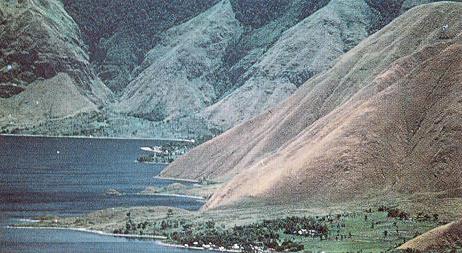
Indonesia

An introduction to the geography, economy and people of Indonesia.
Indonesia Facts
Indonesia is mostly south of the equator. Indonesia has a tropical climate, hot and humid, but is more temperate around the highland areas. It is made up mostly of six major islands, Sumatra, Kalimantan, Java, Bali, Sulawesi and Irian Jaya. The capital city of Indonesia is Jakarta. Its land area is about 1,919,440 km² and its coastline is 54,716 km long. Some natural disasters, like occasional floods, severe droughts, tsunamis (enormous destructive sea waves), earthquakes and volcano eruptions occur here. Most of Indonesia (about 60%) is forested. Indonesia is mostly coastal lowlands but larger islands have interior mountains. Lake Toba in Indonesia (below) is a lake in the Sumatran mountains. Puncak Jaya in Irian Jaya is the highest mountain, about 5030 m tall. Current environmental issues include deforestation, water pollution from industrial wastes or sewage, air pollution in urban areas and smoke and haze from forest fires. Indonesia's natural resources are petroleum, tin, natural gas, nickel, timber, bauxite, copper, fertile soils, coal, gold and silver. Major cities in Indonesia are Banda Aceh, Padang and Palembang in Sumatra, Yogyakarta and Surabaya in Java, Denpasar in Bali, Pontianak in Kalimantan and Ambon in Ceram.

Indonesia is a republic. President Abdurrahman Wahid is both the head of government and the head of state. The Cabinet Ministers are appointed by the president and deal with executive issues. Indonesia's parliament is the unicameral House of Representatives or Dewan Perwakilan Rakyat (DPR) (with 500 seats, 462 elected by popular vote, 38 are appointed military representatives and members serve five-year terms). The People's Consultative Assembly (Majelis Permusyawaratan Rakyat or MPR) including the DPR plus 200 indirectly selected members meets every five years to elect the president and vice president and yearly to approve the broad outlines of national policy. In the Supreme Court (Mahkamah Agung), the judges are appointed by the president.
The Indonesian economy stabilized in 1999, following the sharp contraction and high inflation of 1998 and financial crisis in 1997. By following strict monetary policy, the government reduced inflation from over 70% in 1998 to 2% in 1999. Although interest rates jumped as high as 70% in response to the economic contraction, they fell rapidly to the 10% to 15% range. The economy stopped its freefall as Indonesian GDP showed some growth in the second half of 1999, although GDP for the year as a whole showed no growth at all. The government managed to recapitalize a handful of private banks and has begun recapitalizing the state-owned banking sector. However, new lending remains nearly unavailable as banks continue to be reluctant to issue new debt in a country where little progress has been made in restructuring the large number of outstanding debts. IMF payments were suspended late in 1999 as the result of evidence that a private bank had illegally funneled payments it received from the government to a political party. The government has forecast growth of 3.8% for financial year 2000/01. The spread of violence and continuing dissatisfaction with the pace of restructuring will make it difficult for Indonesia to attract the private investment necessary. 21% percent of its economy is agriculture. Indonesia's unemployment rate is about 15%-20% according to some estimates and inflation is at 2%. Indonesia's currency is the rupiah.
The population of Indonesia is about 225,000,000 and the population growth rate is about 1.6%. Life expectancy is around 68 years at birth. Indonesia is mainly Javanese (45%) and Sumatran (14%). Madurese (7.5%) and Malays (7.5%) are the other main ethnic groups. However, there are over a hundred different ethnic groups in Indonesia. Religions in Indonesia are Muslim 88%, Protestant 5%, Roman Catholic 3%, Hindu 2%, Buddhist 1%, other 1%. Languages spoken in Indonesia are Bahasa Indonesia (an official, modified form of Malay (note: in Malay, 'c' is pronounced as 'ch')), English, Dutch, local dialects, the most widely spoken of which is Javanese. The literacy rate is 83.8%.
Ideally, this website should be viewed using Internet Explorer 5.